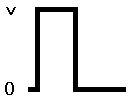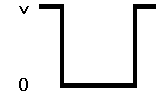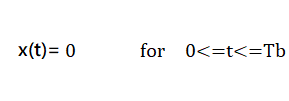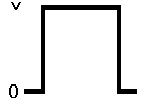



Unipolar signaling is also called as On-Off Keying or simply OOK.
The presence of pulse represents a 1 and the absence of pulse represents a 0.
Select RZ/NRZ from below tabs-
In this type of unipolar signaling, a High in data is represented by a positive pulse called as Mark, which has a duration T0 equal to the symbol bit duration. A Low in data input has no pulse.




In this type of unipolar signaling, a High in data, though represented by a Mark pulse, its duration T0 is less than the symbol bit duration. Half of the bit duration remains high but it immediately returns to zero and shows the absence of pulse during the remaining half of the bit duration.





** Hover over RZ/NRZ graphs for more info
NRZ
Advantage: NRZ encoding requires less Bandwidth as it requires one transition only to encode one bit.
Disadvantage: As continuous set of zeros or ones is transmitted, self-synchronization is a problem in NRZ encoding.
RZ
Advantage: The transition at the middle of bit in Return-to-zero(RZ) provides better synchronization.
Disadvantage: To Encode one bit in Return-to-zero(RZ) encoding, two transitions are required. So, it is requires more Bandwidth.